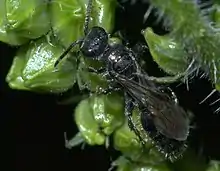| Tiphiid wasps | |
|---|---|
 | |
| Tiphia sp. | |
| Scientific classification | |
| Domain: | Eukaryota |
| Kingdom: | Animalia |
| Phylum: | Arthropoda |
| Class: | Insecta |
| Order: | Hymenoptera |
| Superfamily: | Tiphioidea |
| Family: | Tiphiidae Leach, 1815 |
| Subfamilies | |
| |
The Tiphiidae (also known as tiphiid wasps,[1] flower wasps,[2][note 1] or tiphiid flower wasps[3]) are a family of large, solitary wasps whose larvae are parasitoids of various beetle larvae, especially those in the superfamily Scarabaeoidea.[4] Until recently, this family contained several additional subfamilies, but multiple studies have independently confirmed that these comprise a separate lineage, and are now classified in the family Thynnidae.[5][6]
The females of some Brachycistidinae are wingless, and hunt ground-dwelling (fossorial) beetle larvae.[4] The prey is paralysed with the female's sting, and an egg is laid on it so the wasp larva has a ready supply of food. As some of the ground-dwelling scarab species attacked by tiphiids are pests, some of these wasps are considered beneficial as biological control agents.
Taxonomy
Tiphiid genera are classified as follows: [7][8][9]


Subfamily Brachycistidinae Kimsey, 1991
- Acanthetropis Wasbauer, 1958
- Brachycistellus Baker, 1907
- Brachycistina Malloch, 1926
- Brachycistis Fox, 1893
- Brachymaya Kimsey & Wasbauer 1999
- Colocistis Krombein, 1942
- Dolichetropis Wasbauer, 1968
- Glyptacros Mickel & Krombein, 1942
- Hadrocistis Wasbauer, 1968
- Paraquemaya Kimsey & Wasbauer, 1999
- Sedomaya Kimsey & Wasbauer, 1999
- Stilbopogon Mickel & Krombein, 1942
Subfamily Tiphiinae Leach, 1815
- Cabaraxa Nagy, 1974
- Cyanotiphia Cameron, 1907
- Epomidiopteron Romand, 1835
- Icronatha Nagy, 1967
- Krombeinia Pate, 1947
- Ludita Nagy, 1967
- Mallochessa Allen, 1972
- Megatiphia Kimsey, 1993
- Neotiphia Malloch, 1918
- Paratiphia Sichel, 1864
- † Philoponites Cockerell, 1915[10]
- Pseudotiphia Ashmead 1903
- Tiphia Fabricius, 1775
Examples
- Tiphia femorata Linden 1827
- Tiphia minuta Fabricius, 1775
Notes
- ↑ Not to be confused with other flower wasps in Mutillidae, Scoliidae, or Thynnidae.
References
- ↑ Obeysekara, Piyumi T.; Legrand, Ana (2014). "The Influence of Host Species and Location in the Host Detection Ability of Tiphiid (Hymenoptera: Tiphiidae) Parasitoids". Environmental Entomology. 43 (6): 1594–1602. doi:10.1603/EN13275. PMID 25289963. S2CID 31183862.
- ↑ "Flower wasps". The Australian Museum. 2020. Retrieved September 9, 2023.
- ↑ Kelaidis, Panayoti; Tankersley, Boyce; Zale, Peter (2019). "November 2019" (PDF). International Rock Gardener (119): 115 pp. ISSN 2053-7557. Retrieved September 9, 2023.
- 1 2 Brothers, Denis J. (1993). "Key to subfamilies of Tiphiidae". In Goulet, Henri; Huber, John T. (eds.). Hymenoptera of the World, an Identification Guide to Families. Ottawa, Ontario: Centre for Land and Biological Resources Research. pp. 178–185. ISBN 0-660-14933-8.
- ↑ Pilgrim, E.; von Dohlen, C.; Pitts, J. (2008). "Molecular phylogenetics of Vespoidea indicate paraphyly of the superfamily and novel relationships of its component families and subfamilies". Zoologica Scripta. 37 (5): 539–560. doi:10.1111/j.1463-6409.2008.00340.x. S2CID 85905070.
- ↑ Johnson, B.R.; et al. (2013). "Phylogenomics Resolves Evolutionary Relationships among Ants, Bees, and Wasps". Current Biology. 23 (20): 2058–2062. doi:10.1016/j.cub.2013.08.050. PMID 24094856.
- ↑ "Taxonomy for Tiphiinae". insectoid.info. Retrieved 13 May 2017.
- ↑ "Tiphiinae". Fauna Europaea. Archived from the original on April 6, 2016. Retrieved 13 May 2017.
- ↑ Lynn S. Kimsey; Marius Wasbauer (2006). "Phylogeny and Checklist of the Nocturnal Tiphiids of the Western Hemisphere (Hymenoptera: Tiphiidae: Brachycistidinae)". Journal of Hymenoptera Research. 15 (1): 9–25.
- ↑ Antropov, A.V. (2014). "Aculeata Scopoli, 1763. The wasps, bees and ants (Insecta: Vespida=Hymenoptera) from the Insect Limestone (Late Eocene) of the Isle of Wight, UK" (PDF). Earth and Environmental Science Transactions of the Royal Society of Edinburgh. 104 (3–4): 335–446. doi:10.1017/S1755691014000103. S2CID 85699800.
Further reading
- Arnett, R. H. Jr. (2000) Segunda edición. American insects. CRC Press, Boca Raton, Londres,New York, Washington, D. C. ISBN 0-8493-0212-9
- Borror, D. J., DeLong, D. M., Triplehorn, C. A.(1976) cuarta edición. An introduction to the study of insects. Holt, Rinehart and Winston. New York, Chicago. ISBN 0-03-088406-3